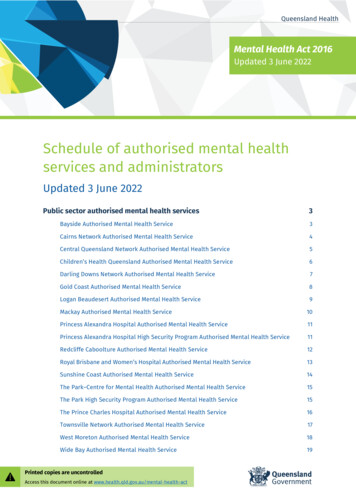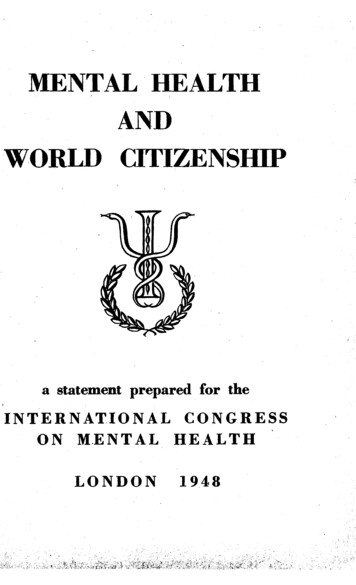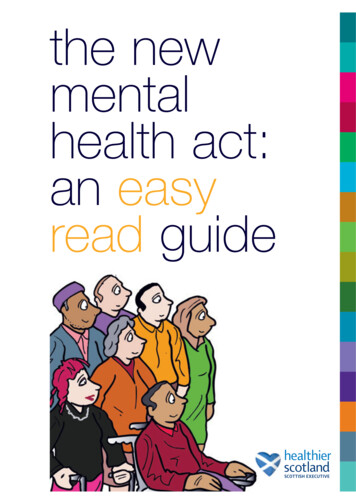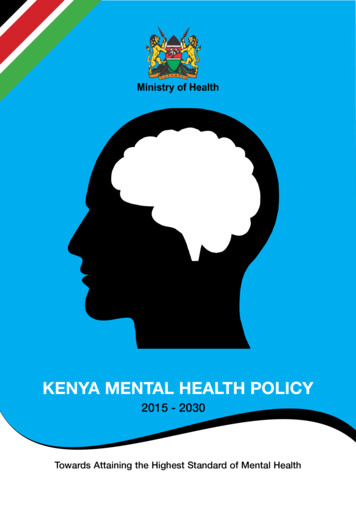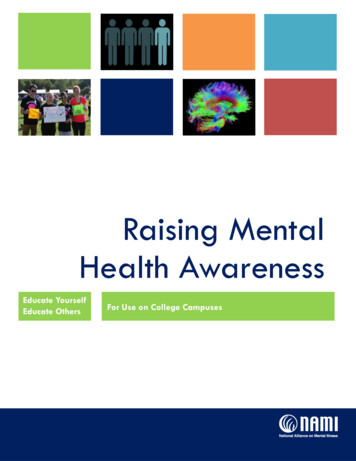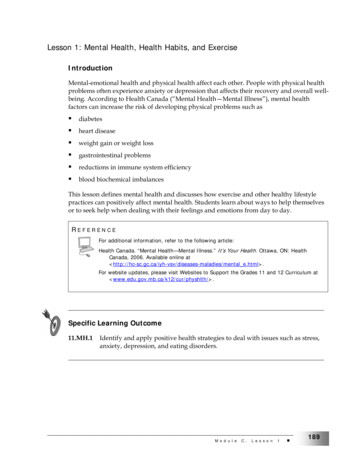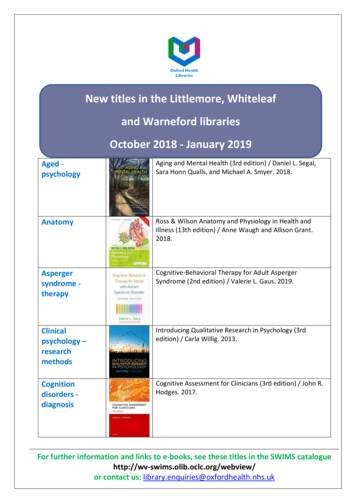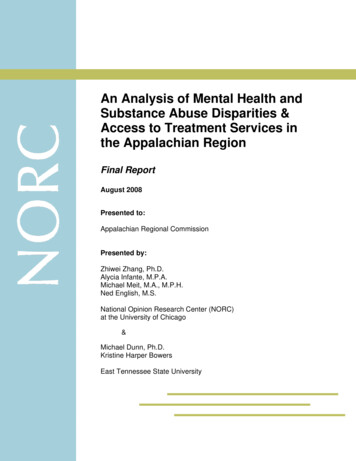
Transcription
An Analysis of Mental Health andSubstance Abuse Disparities &Access to Treatment Services inthe Appalachian RegionFinal ReportAugust 2008Presented to:Appalachian Regional CommissionPresented by:Zhiwei Zhang, Ph.D.Alycia Infante, M.P.A.Michael Meit, M.A., M.P.H.Ned English, M.S.National Opinion Research Center (NORC)at the University of Chicago&Michael Dunn, Ph.D.Kristine Harper BowersEast Tennessee State University
You can view and download this report by visiting www.arc.gov or www.norc.org.For more information about the report, please contact either Gregory Bischak, Ph.D. of theAppalachian Regional Commission (202-884-7790, gbischak@arc.gov) or Michael Meit, M.A.,M.P.H. of NORC (301-634-9324, meit-michael@norc.org)The authors wish to thank the Appalachian Regional Commission for providing the funding for thereport.Appalachian Regional Commission1666 Connecticut Avenue, NW, Suite 700Washington, DC 20009-1068The Appalachian Regional Commission’s mission is to be an advocate for and partner with thepeople of Appalachia to create opportunities for self-sustaining economic development andimproved quality of life.National Opinion Research Center4250 East-West Highway, Suite 800Bethesda, MD 20814NORC’s mission is to conduct high quality social science research in the public interest. Weconduct research in health, economics, demographics, education and child development, substanceabuse, mental health, justice, and survey quality both in the U.S. and internationally. NORCsupports the research needs of governments in the U.S. and abroad, international donor agencies,foundations, academic researchers, and private organizations. NORC has offices in Chicago, IL,Bethesda, MD, and Berkeley, CA.East Tennessee State University 2008 by the Appalachian Regional Commission and the National Opinion Research CenterReproduction of this document is permitted and encouraged, with credit given to the AppalachianRegional Commission and the National Opinion Research Center.
AcknowledgmentsThis report was funded and prepared for the Appalachian Regional Commission (ARC). It wascommissioned by the ARC to study the disparities in mental health status and substance abuseprevalence and access to treatment services in the Appalachian Region.The National Opinion Research Center (NORC) at the University of Chicago, in partnership withEast Tennessee State University (ETSU), conducted this study. Zhiwei Zhang, Ph.D. is the leadauthor and Principal Investigator and Michael Meit, M.A., M.P.H. is the Project Manager.Contributing authors to this report were Alycia Infante, M.P.A. and Ned English, M.S. from NORC,and Michael Dunn, Ph.D. and Kristine Harper Bowers from East Tennessee State University(ETSU).The research, analysis, and report development were guided by Dr. Gregory Bischak, SeniorEconomist with the ARC. We would like to acknowledge the important contributions of RandallJessee, Ph.D. and the members of the Center for Appalachian Substance Abuse Policy (CASAP) fortheir initial project guidance and review of draft findings, and the members of the AppalachianHealth Policy Advisory Council (AHPAC) for their ongoing project guidance and support. We alsothank Bruce Behringer, M.P.H. at East Tennessee State University for his guidance andcontributions. We appreciate the assistance provided by Katherine Locke, M.P.H., EmilyShortridge, Ph.D., Jacob Feldman, Ph.D., and Sam Schildhaus, Ph.D. from NORC. We thank ArtHughes at the Office of Applied Studies (OAS) of the Substance Abuse and Mental Health ServicesAdministration (SAMHSA) and staff at Research Triangle Institute International Inc. for runningdata on the National Survey on Drug Use and Health (NSDUH). We thank Deborah Trunzo atOAS/SAMHSA and Leigh Henderson at the Synectics for Management Decisions, Inc forproviding the Treatment Episode Data Sets (TEDS) submitted by Appalachian states andjurisdictions.The data collection in the field for the case study part of this project was approved by the EastTennessee State University’s Institutional Review Board. All the data collection, analysis, reporting,and subsequent publications were approved by NORC’s Institutional Review Board.The views expressed are those of the authors and not necessarily those of ARC, NORC, or the EastTennessee State University.
TABLE OF CONTENTSExecutive Summary . 1CHAPTER 1: Introduction . 71.11.21.31.4Substance Abuse and Mental Health Disorders in Appalachia . 7Key Research Questions and Methodology . 8Importance of the Current Study . 9Structure of the Report . 11CHAPTER 2: Substance Use, Mental Disorders, and Access to Treatment Services inHousehold Surveys, 2002 – 2005 . 192.1 Introduction . 192.2 Data . 192.2.1 Overview . 192.2.2 Limitations of the NSDUH . 202.3 Methods . 212.3.1 Analytic Sample . 212.3.2 Measures. 212.3.3 Statistical Methods . 232.4 Results . 242.4.1 Tables . 292.4.2 Maps . 542.5 Discussion . 75CHAPTER 3: Patient Admissions to Treatment for Abuse of Alcohol and Drugs inAppalachia, 2000 – 2004 . 783.1 Introduction . 783.2 Data . 783.2.1 Overview . 783.2.2 Uses of TEDS . 803.2.3 TEDS Measures Used in this Study . 803.2.4 Limitations of the TEDS Series . 833.3 Methods . 833.3.1 Study Sample. 833.3.2 Statistical Methods . 843.4 Results . 843.4.1 Tables . 853.4.2. Figures . 1043.4.3. Maps . 110
3.5 Discussion . 121CHAPTER 4: Substance Use and Mental Health Disorder Discharges from Appalachian andOther Community Hospitals in 2004 . 1244.1 Introduction . 1244.2 Data . 1254.2.1 Overview . 1254.2.2 Sample Design. 1254.2.3 Uses of the HCUP Nationwide Inpatient Sample . 1264.2.4 HCUP Measures Used in this Study . 1264.2.5 Limitations of HCUP NIS Data . 1284.3 Methods . 1294.3.1 Study Sample. 1294.3.2 Statistical Methods . 1294.4 Results . 1304.4.1 Tables . 1304.5 Discussion . 150CHAPTER 5: Substance Abuse Treatment Services in the Appalachian Region, 2005 . 1525.1 Introduction . 1525.2 Data . 1525.2.1 Overview . 1525.2.2 Sample Design. 1535.2.3 Uses of the N-SSATS . 1545.2.4 N-SSATS Measures Used in this Study . 1545.2.5 Limitations of the N-SSATS . 1555.3 Methods . 1565.3.1 Study Sample. 1565.3.2 Statistical Methods . 1565.4 Results . 1565.4.1 Tables . 1575.4.2 Figures . 1625.5 Discussion . 166CHAPTER 6: Substance Abuse and Mental Health – A Comparison of Appalachian CoalMining Areas to Other Areas within the Appalachian Region . 1686.1 Introduction . 1686.2 Data and Analytic Samples. 1686.3 Results . 1706.4 Conclusion . 173
CHAPTER 7: Case Study Analysis of Disparities in Mental Health Status and SubstanceAbuse Prevalence in the Appalachian Region and Access to Mental Health and SubstanceAbuse Treatment Services . 1817.1 Introduction . 1827.2 Case Study Process . 1827.3 Phase 1: Identification of Potential Data Sets/Sources . 1837.4 Phase 2: Selection of Pairs of Counties for Case Study . 184Data Sources . 184Measuring the Similarities of County Pairs . 185Composite Ranking Scale and Selection of Final Pairs . 186Site Descriptions . 1887.5 Phase 3: Onsite Focus Group and Key Informant Interviews . 1937.6 Phase 4: Development of Community Resource Inventory . 1987.7 Phase 5: Key Findings . 2017.8 Discussion and Conclusions . 206Case Study Appendix of Model Programs . 210County Profiles . 214CHAPTER 8: Conclusions . 215APPENDIX A: Data Sources . 223APPENDIX B: Literature Review of the Prevalence of Substance Abuse and Mental HealthDisorders, Access to Treatment Services, and Disparities in Appalachia. 225APPENDIX C: Results from the 2005 National Survey on Drug Use and Health: NationalFindings . 235APPENDIX D: County-Level Data Profiles for Appalachian Case Studies . 274References . 287TABLESTable 1.1 Overview of the Data Sets: Data Coverage, Data Reliability, and Characteristics. 12Table 2.1 Sample Sizes of the Pooled National Surveys on Drug Use and Health, by Age Group,Survey Year, and Appalachian Region Status . 21Table 2.2 Demographic Characteristics and Health Insurance among Persons Aged 12 or Older, byAge Group and Appalachian Region Status: Percentages, Annual Averages Based on 20022005 . 29Table 2.3 Lifetime, Past Year, and Past Month Substance Use among Persons Aged 12 or Older, bySubstance, Age Group, and Appalachian Region Status: Percentages, Annual Averages Basedon 2002-2005. 30
Table 2.4 Substance Dependence or Abuse, Mental Health Measures, and Receipt of SubstanceUse Treatment in the Past Year among Persons Aged 12 or Older, by Age Group andAppalachian Region Status: Percentages, Annual Averages Based on 2002-2005 . 31Table 2.5 Demographic Characteristics and Health Insurance among Persons Aged 12 or OlderResiding in Appalachian Region, by Age Group and Appalachian Sub-Region: Percentages,Annual Averages Based on 2002-2005 . 32Table 2.6 Lifetime, Past Year, and Past Month Substance Use among Persons Aged 12 or OlderResiding in Appalachian Region, by Substance, Age Group, and Appalachian Sub-Region:Percentages, Annual Averages Based on 2002-2005 . 33Table 2.7 Substance Dependence or Abuse, Mental Health Measures, and Receipt of SubstanceUse Treatment in the Past Year among Persons Aged 12 or Older Residing in AppalachianRegion, by Age Group and Appalachian Sub-Region: Percentages, Annual Averages Based on2002-2005. 34Table 2.8 Demographic Characteristics and Health Insurance among Persons Aged 12 or OlderResiding in Appalachian Region, by Age Group and Appalachian Socioeconomic Status:Percentages, Annual Averages Based on 2002-2005 . 36Table 2.9 Lifetime, Past Year, and Past Month Substance Use among Persons Aged 12 or OlderResiding in Appalachian Region, by Substance, Age Group, and Appalachian SocioeconomicStatus: Percentages, 2002-2005. 38Table 2.10 Substance Dependence or Abuse, Mental Health Measures, and Receipt of SubstanceUse Treatment in the Past Year among Persons Aged 12 or Older Residing in AppalachianRegion, by Age Group and Appalachian Socioeconomic Status: Percentages, Annual AveragesBased on 2002-2005 . 39Table 2.11 Access to Alcohol Treatment among Persons Aged 12 or Older, by Age Group andAppalachian Region Status: Percentages, Annual Averages Based on 2002-2005 . 44Table 2.12 Access to Drug Treatment among Persons Aged 12 or Older, by Age Group andAppalachian Region Status: Percentages, Annual Averages Based on 2002-2005 . 45Table 2.13 Reasons for Not Receiving Substance Use Treatment and Locations of Treatmentamong Persons Aged 12 or Older, by Age Group and Appalachian Region Status:Percentages, Annual Averages Based on 2002-2005 . 46Table 2.14 Reasons for Not Receiving Mental Health Treatment among Persons Aged 12 orOlder, by Age Group and Appalachian Region Status: Percentages, Annual Averages Based on2002-2005. 47Table 2.15 Access to Alcohol Use Treatment among Persons Aged 12 or Older, by Age Groupand Appalachian Sub-Region: Percentages, Annual Averages Based on 2002-2005. 48Table 2.16 Access to Drug Use Treatment among Persons Aged 12 or Older, by Age Group andAppalachian Sub-Region: Percentages, Annual Averages Based on 2002-2005 . 49Table 2.17 Reasons for Not Receiving Mental Health Treatment among Persons Aged 12 orOlder, by Age Group and Appalachian Sub-Region: Percentages, Annual Averages Based on2002-2005. 50Table 2.18 Access to Alcohol Use Treatment among Persons Aged 12 or Older, by Age Groupand Appalachian Socioeconomic Status: Percentages, Annual Averages Based on 2002-200551Table 2.19 Access to Drug Treatment among Persons Aged 12 or Older, by Age Group andAppalachian Socioeconomic Status: Percentages, Annual Averages Based on 2002-2005 . 52Table 2.20 Reasons for Not Receiving Mental Health Treatment/Counseling among Persons Aged12 or Older, by Age Group and Appalachian Socioeconomic Status: Percentages, AnnualAverages Based on 2002-2005 . 53
Table 3.1: Sub-regional Differences of Admissions to Substance Abuse Treatment in theAppalachian Region, By Demographics . 86Table 3.2: Sub-regional Differences of Admissions to Substance Abuse Treatment in theAppalachian Region, By Employment Status, Marital Status, and Pregnancy Status . 88Table 3.3: Sub-regional Differences of Admissions to Substance Abuse Treatment in theAppalachian Region, By Health Insurance and Source of Referral . 91Table 3.4: Sub-regional Differences of Admissions to Substance Abuse Treatment in theAppalachian Region, By Service Setting . 93Table 3.5: Sub-regional Differences of Admissions to Substance Abuse Treatment in theAppalachian Region, By Types of Services and Methadone Use As Part of Treatment . 95Table 3.6: Sub-regional Differences of Admissions to Substance Abuse Treatment in theAppalachian Region, By Prior Treatment Episodes and Expected Source of Payment. 97Table 3.7: Sub-regional Differences of Admissions to Substance Abuse Treatment in theAppalachian Region, By Use as a Primary Reason for Admission . 99Table 3.8: Sub-regional Differences of Admissions to Substance Abuse Treatment in theAppalachian Region, By One Major Reason for Admission . 101Table 3.9: Sub-regional Differences of Admissions to Substance Abuse Treatment in theAppalachian Region, By Psychological Problem and Mood Disorder Upon Admission . 103Table 4.1. AHRQ-developed Mental Health and Substance Abuse Clinical Classification Software(CCS-MHSA) . 129Table 4.2a: Demographics of Community Hospital Discharges in the Appalachian Region(Unweighted) . 132Table 4.2b: Demographics of Community Hospital Discharges in the Appalachian Region(Unweighted) by County Economic Development Status, 2004 . 133Table 4.3a: Admission Source, Type, and Expected Payment for Community Hospital Discharges inAppalachia (Unweighted), 2004 . 136Table 4.3b: Admission Source, Type, and Expected Payment for Community Hospital Discharges inAppalachia (Unweighted) by County Economic Development Status, 2004 . 137Table 4.4a: Hospital Stay Characteristics for Community Hospital Discharges in Appalachia(Unweighted), 2004 . 138Table 4.4b: Hospital Stay Characteristics for Community Hospital Discharges in Appalachia byCounty Economic Development Status (Unweighted), 2004 . 139Table 4.5a: Diagnoses and Principal Reason for Hospitalization for Community HospitalDischarges in Appalachia (Unweighted), 2004. 141Table 4.5b: Diagnoses and Principal Reason for Hospitalization for Community HospitalDischarges in Appalachia (Unweighted), by County Economic Development Status, 2004 . 142Table 4.6a: Differences Among All Principal and Secondary Mental Health or Substance AbuseDiagnoses for Discharges from Community Hospitals, 2004 . 144Table 4.6b: Differences Among All Principal and Secondary Mental Health or Substance AbuseDiagnoses Discharged from Community Hospitals, by County Economic Development Status,2004 . 145Table 4.7a: Differences Among Community Hospital Discharges by Substance Abuse and MentalHealth Diagnoses as the Major Reason for Hospitalization, 2004 . 147Table 4.7b: Differences Among Community Hospital Discharges by Substance Abuse and MentalHealth Diagnoses as the Major Reason for Hospitalization by County Economic DevelopmentStatus, 2004 . 148Table 4.8: Adult Patients Diagnosed with Mental Health Disorders in Community Hospitals, 2004. 149
Table 5.1: Ownership and Other Characteristics of Substance Abuse Treatment Facilities, 2005. 157Table 5.2 Characteristics of Substance Abuse Treatment Facilities, 2005 . 158Table 5.3: Inpatient, Outpatient, and Non-Hospital Residential Care Offered at Substance AbuseTreatment Facilities, 2005 . 159Table 5.4 Counseling and Pharacotherapies Available at Treatment Facilities, 2005 . 160Table 5.5 Services Available at Treatment Facilities, 2005 . 161Table 6.1: Trend of Heroin Use as Primary, Secondary, or Tertiary Reason for Treatment, by CoalMining Status of Patient Location . 172Table 6.2: Trend of Other Opiates or Synthetics Use as Primary, Secondary, or Tertiary Reason forTreatment, by Coal Mining Status of Patient Location . 173Table 6.3: Characteristics of Hospital Stays in Community Hospitals in the Appalachian Region,Adults Aged 18 or Older, by County Coal Mine Status. 175Table 6.4: Characteristics of Admissions to Substance Abuse Specialty Treatment in theAppalachian Region, by County Coal Mine Status, 2000-2004 . 176Table 6.5: Treatment-Related Characteristics of Admissions to Substance Abuse Treatment in theAppalachian Region, by County Coal Mine Status, 2000-2004 . 178Table 6.6: Substance Abuse Characteristics of Admissions to Substance Abuse Treatment in theAppalachian Region, by County Coal Mine Status, 2000-2004 . 180Table 7.1. Selected Four Pairs of Counties Per State in the Appalachian Region Based on theComposite Ranking Score . 187Table 7.2. Model Programs (Best Practices) from Appalachian Twinned-County Focus
commissioned by the ARC to study the disparities in mental health status and substance abuse prevalence and access to treatment services in the Appalachian Region. The National Opinion Research Center (NORC) at the University of Chicago, in partnership with East Tennessee State University (ETSU), conducted this study. Zhiwei Zhang, Ph.D. is the .

